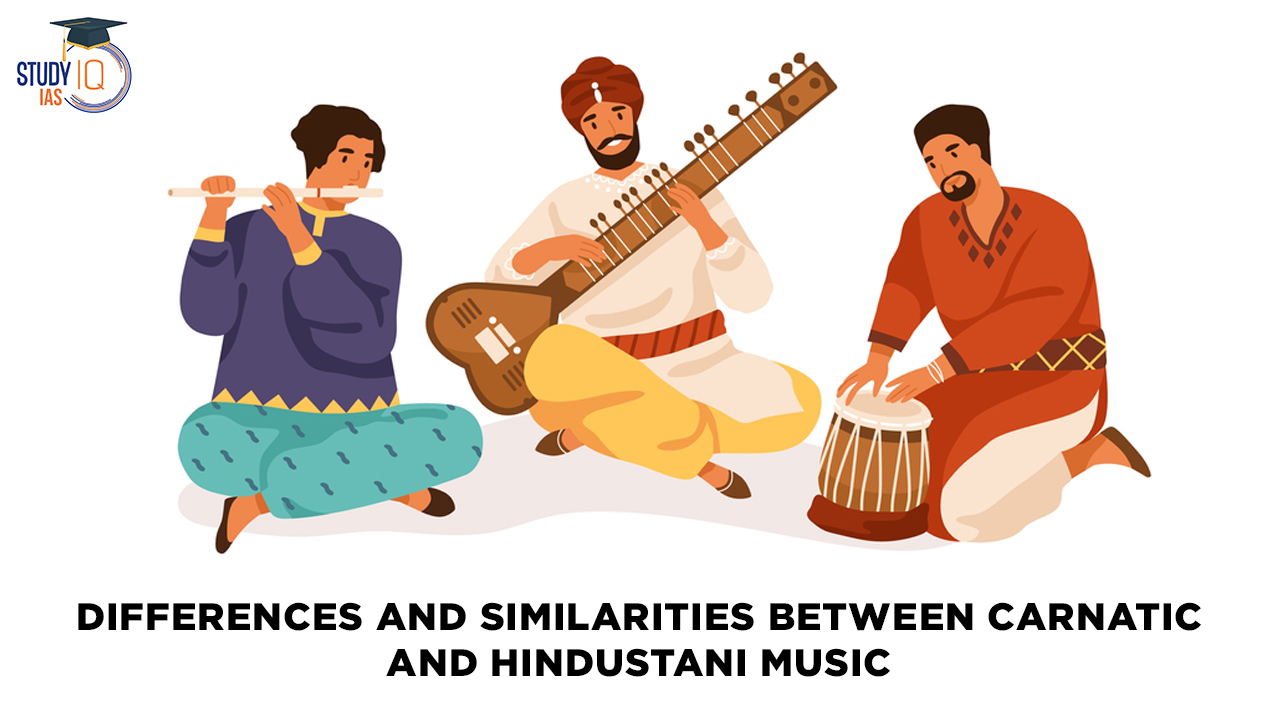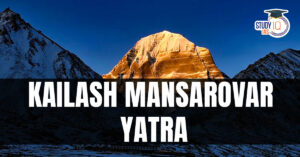Table of Contents
Indian classical music, deeply rooted in the philosophical concept of ‘Naad’ as the basis of all existence, traces its origins to the Samaveda, specifically the Gandharva Veda. The later Vedic period witnessed the prevalence of ritualistic music. Bharata Muni’s Natyashastra in the 4th century CE and Matanga’s Brihaddeshi in the 9th century provided foundational theories, introducing ‘srutis’ and focusing on ragas. The transition from the Vedic Age to the medieval period marked the division of Indian music into Hindustani and Carnatic branches around the 14th century CE.
We’re now on WhatsApp. Click to Join
Characteristics of Hindustani and Carnatic Music
Hindustani music, originating during the Delhi Sultanate period, bears the imprint of Persian and diverse musical influences. Its forms include Dhrupad, Khayal, Tarana, Thumri, Dadra, and Ghazals, accompanied by instruments like Tabla, Sarangi, and Santoor.
On the other hand, Carnatic music, born from the Bhakti movement and shaped by the trinity of composers, remains distinctly indigenous. Forms such as Alapana, Niraval, and Kalphaswaram showcase their unique melodic and rhythmic intricacies, accompanied by instruments like Veena and Mridangam. Both traditions share fundamental pillars of Swara, Raga, and Taala, yet their historical development, influences, and stylistic nuances contribute to the rich tapestry of Indian classical music.
Examples of Carnatic and Hindustani Music
| Hindustani Music | Carnatic Music |
| Dhrupad Khayal Tarana Thumri Dadra Gazals |
Alapana Niraval Kalpanaswaram Ragam Thana Pallavi |
Similarities Between Carnatic And Hindustani Music
The similarities between Carnatic and Hindustani music are rooted in their shared foundational elements, linguistic and Vedic heritage, spiritual connections, emphasis on Raga, focus on melody, commonality in musical language, and the use of a monophonic structure with the support of the drone. These shared aspects highlight the underlying unity within the diverse landscape of Indian classical music.
Common Foundation of Swara, Raga, and Taala
Hindustani and Carnatic music both share a common foundation built upon the fundamental elements of Swara (musical notes), Raga (melodic framework), and Taala (rhythmic cycles). These elements provide the structural framework for compositions and performances in both traditions.
Evolution with Sanskrit and Vedic Tradition
Sanskrit Language: Both traditions have evolved in conjunction with the Sanskrit language, with many classical compositions being written in Sanskrit. The language has played a crucial role in preserving the authenticity and tradition of the music.
Vedic Tradition: The influence of the Vedic tradition is evident in both Hindustani and Carnatic music. The foundational principles of these musical forms find resonance in the ancient Vedic scriptures, contributing to the spiritual and philosophical dimensions of the music.
Spiritual and Religious Origins
Spirituality and Religion: Both Hindustani and Carnatic music have deep-rooted connections to spirituality and religion. Many classical compositions in both traditions are dedicated to expressing devotion and spiritual sentiments, reflecting the cultural and religious diversity of India.
Central Notion of Raga
Raga as Central Concept: The central notion in both traditions is the concept of a Raga. A Raga serves as the foundational structure for melodic expression, providing a set of rules and guidelines within which the musician can improvise and create.
Prominence to Melody
Principal Focus on Melody: Both styles give significant importance to the melody in their musical expressions. The intricate melodic patterns and improvisations in both Hindustani and Carnatic music showcase the beauty and depth of the musical journey.
Use of Sampoorna Scale for Janya Raga
Sampoorna Scale for Janya Raga: In both traditions, the description of Janya Ragas involves the use of the Sampoorna (complete) scale. This scale provides a comprehensive framework for understanding the melodic nuances and relationships within a given Raga.
Monophonic Nature and Use of Taanpura
Monophonic Character: Both Hindustani and Carnatic music are monophonic, emphasizing a single melodic line. This characteristic allows for intricate exploration and elaboration of the chosen Raga.
Use of Taanpura (Drone): Both traditions commonly use the Taanpura, also known as a drone, as the primary Shruthi (tonal reference). The constant drone serves as a foundation, aiding the musician in maintaining pitch and tonal accuracy during the performance.
Differences Between Carnatic And Hindustani Music
Origin
- Hindustani Music: Originates in the Northern parts of the Indian subcontinent and is referred to as Shastriya Sangeet or North Indian Classical Music. It has its roots in the Vedic period.
- Carnatic Music: Originates in Southern India and is also known as Karnatak music. It has distinct characteristics and evolved in the cultural milieu of Southern India.
Dominant Centres
- Hindustani Music: Chief centres include Jaipur, Gwalior, Agra, Delhi, Varanasi, Mumbai, and Kolkata, reflecting a broader geographical spread.
- Carnatic Music: Principal centres are concentrated in the Southern regions, including Tamil Nadu, Andhra Pradesh, Telangana, Karnataka, and Kerala.
Instruments
- Hindustani Music: Major instruments include Sitar, Sarangi, Sarod, Tabla, Shehnai, and Tambura, showcasing a diverse array of string and percussion instruments.
- Carnatic Music: Prominent instruments are Flute, Ghatam, Violin, Veena, Tamboori, Mridangam, and Kanjira, highlighting a unique set of instruments with a focus on rhythmic diversity.
Compositions
- Hindustani Music: Compositions are relatively lighter, featuring Chaiti, Dhrupad, Dadra, Dhamar, Ghazal, Khyal, Tarana, Tappa, Trivet, Kajari, and Thumri, offering a variety of musical forms.
- Carnatic Music: Compositions are lengthier, more complex, and include Varnam, Javali, Keertana, Kriti, Tillana, Padam, Pallavi, Ragamalika, and Swarajati, showcasing a rich diversity in musical structures.
Core Elements
- Both traditions share the basic elements of Swara, Raga, and Tala as foundational components. Additionally, Hindustani music incorporates Alap, Taan, Jor, Jhala, Gat, and Alankaar, while Carnatic music includes Sruti, Swara, Raga, and Taala as core elements.
Content
- Hindustani Music: Places greater importance on instrumental music, with themes ranging from devotional to romantic.
- Carnatic Music: Vocal music plays a crucial role, and the predominant theme is often devotional, emphasizing the spiritual and cultural context.
Famous Practitioners
- Hindustani Music: Notable practitioners include Bismillah Khan, Ravi Shankar, Ali Akbar Khan, Tansen, Zakir Hussain, Hariprasad Chaurasia, and Shivkumar Sharma.
- Carnatic Music: Renowned artists include M. Balamuralikrishna, M. S. Subbulakshmi, Aruna Sairam, Nithyasree Mahadevan, Semmangudi Srinivasa Iyer, Sudha Raghunathan, and U Srinivas.
Features of Carnatic And Hindustani Music
| Feature | Hindustani Music | Carnatic Music |
| Geographical Origin | North India | South India |
| Raga System | More flexible, allowing for improvisation | More fixed, with precise rules for ragas |
| Tala System | Relatively simpler, with fewer talas | Complex and intricate, with many talas |
| Instruments | Commonly uses tabla, sitar, sarod, and others | Commonly uses mridangam, violin, ghatam, and others |
| Emphasis on Vocal Music | Instrumental and vocal music are both prominent | Vocal music holds a central position |
| Notation System | Relies on the sargam (sa, re, ga, ma, etc.) | Utilizes solfa syllables (sa, ri, ga, ma, etc.) |
| Taans and Gamakas | Taans (fast melodic patterns) are emphasized | Gamakas (ornamentations) are integral |
| Composition Types | Commonly includes bandish and ghazal | Compositions include kriti, varnam, and others |
| Concert Structure | Typically has alap, jor, jhala in instrumental music; vilambit, drut in vocal music | Comprises alapana, krithi, niraval, and swaram |
| Approach to Harmony | Emphasis on melodic structures and improvisation | Emphasis on structured compositions and precise execution |
| Performance Style | More reliance on improvisation and creative expression | Focus on faithful rendition of compositions with scope for embellishments |
| Gharanas (Schools) | Known for various gharanas, each with distinct styles | Less emphasis on specific schools, more on individual teacher-student lineages |
Comparison of Hindustani and Carnatic Music
| Dimensions | Hinsutani Classical Music | Carnatic Classical Music |
| Influence | Arab, Persian, Afghan | Indigenous |
| Freedom | Scope for artists to improvise. Hence scope for variations. | No freedom to improvise |
| Sub-styles | Several sub-styles which led to emergence of ‘Gharanas’ | Only one particular prescribed style of singing |
| Need for instruments | Equally important as vocals | More emphasis on vocal music |
| Ragas | 6 major ragas | 72 ragas |
| Time | Adheres to time | Doesn’t adhere to any time |
| Instruments | Table, Sarangi, Sitar, and Santoor | Veena, Mrindangum, and Mandolin |
| Association to Parts of India | North India | South India |
| Commonality | Flute and Violin |
Carnatic Vs. Hindustani Music UPSC
Carnatic and Hindustani music are two distinct traditions within Indian classical music. Carnatic music, predominant in South India, is characterized by its fixed compositions, intricate rhythmic patterns, and emphasis on vocal expression. It employs a vast array of ragas (melodic frameworks) and talas (rhythmic cycles).
In contrast, Hindustani music, prevalent in North India, allows greater scope for improvisation, with artists often creating unique renditions. It features ‘Gharanas’ or stylistic schools, highlighting diverse musical lineages. While Carnatic music adheres to specific ragas and talas, Hindustani music fosters a more flexible, dynamic approach, reflecting regional and historical influences. Both traditions contribute richly to India’s cultural tapestry.


 Golconda Blue Diamond, a Rare Gem from I...
Golconda Blue Diamond, a Rare Gem from I...
 Kailash Mansarovar Yatra to Resume Soon,...
Kailash Mansarovar Yatra to Resume Soon,...
 Bihu Festival and Dance of Assam, Histor...
Bihu Festival and Dance of Assam, Histor...





















